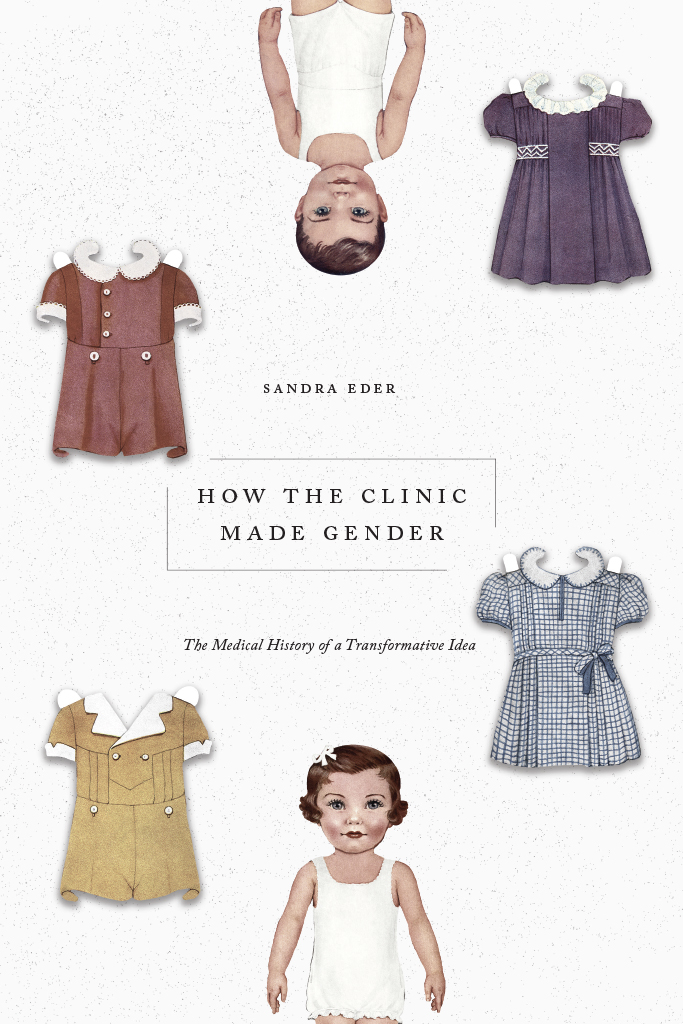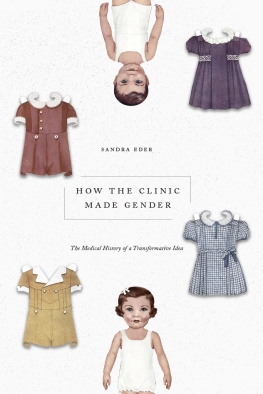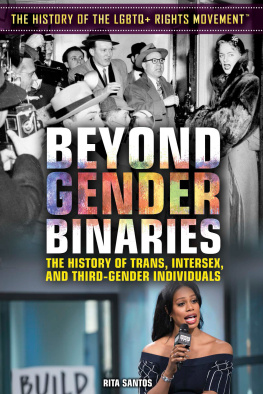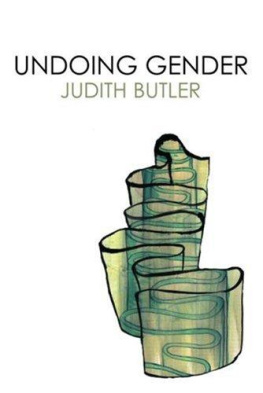
How the Clinic Made Gender
How the Clinic Made Gender
The Medical History of a Transformative Idea
Sandra Eder
The University of Chicago Press
Chicago and London
The University of Chicago Press, Chicago 60637
The University of Chicago Press, Ltd., London
2022 by The University of Chicago
All rights reserved. No part of this book may be used or reproduced in any manner whatsoever without written permission, except in the case of brief quotations in critical articles and reviews. For more information, contact the University of Chicago Press, 1427 E. 60th St., Chicago, IL 60637.
Published 2022
Printed in the United States of America
31 30 29 28 27 26 25 24 23 22 1 2 3 4 5
ISBN-13: 978-0-226-57332-8 (cloth)
ISBN-13: 978-0-226-81993-8 (paper)
ISBN-13: 978-0-226-57346-5 (e-book)
DOI: https://doi.org/10.7208/chicago/9780226573465.001.0001
Library of Congress Cataloging-in-Publication Data
Names: Eder, Sandra, author.
Title: How the clinic made gender : the medical history of a transformative idea / Sandra Eder.
Description: Chicago : University of Chicago Press, 2022. | Includes bibliographical references and index.
Identifiers: LCCN 2021047903 | ISBN 9780226573328 (cloth) | ISBN 9780226819938 (paperback) | ISBN 9780226573465 (ebook)
Subjects: LCSH: Gender identityUnited States. | Intersex peopleUnited States. | MedicineUnited StatesHistory.
Classification: LCC HQ1075.5.U5 E33 2022 | DDC 305.30973dc23
LC record available at https://lccn.loc.gov/2021047903
 This paper meets the requirements of ANSI/NISO Z39.48-1992 (Permanence of Paper).
This paper meets the requirements of ANSI/NISO Z39.48-1992 (Permanence of Paper).
Contents
Charles was born in 1955. He was a sickly infant, a poor eater, and prone to vomiting, but by the age of fifteen months his health had improved. His doctor described him as a very happy and healthy boy. When he was two years old, his parents became increasingly concerned that his penis appeared too large for his age and that he had started growing pubic hair. They first saw a local physician, who tested the childs androgen production, measured his bone age, and did a buccal smear test to determine his sex chromosomes. Charles, it turned out, had a female XX pattern. He was, the physician told his parents, actually a girl.
At the time, doctors referred to Charles as a female pseudohermaphrodite. Although Charless anatomy had always been perceived as male, after diagnosing him as a female pseudohermaphrodite, the local physician recommended that he undergo plastic repair on his genitals and be raised as a female.
Charless parents objected to this plan, which came two years after they had been raising him as a son. Their doctor referred them to the Johns Hopkins Hospital in Baltimore to get further evaluations, and three months later, in the spring of 1958, Charles was admitted there. At Hopkins, Lawson Wilkins, whose Pediatric Endocrinology Clinic was located at the adjacent Harriet Lane Home for Invalid Children, was one of the nations leading experts on CAH. In 1950, he had introduced cortisone as treatment for CAH, and starting in 1951 his team consisting of the psychologist John Money and the psychiatrists Joan Hampson and John Hampson had studied the psychological health of children with CAH and developed recommendations for medically managing cases of DSD. Money had introduced the term gender role in 1954 based on a three-year longevity study of patients with intersex at Wilkinss clinic. The team claimed that gender role was determined by the sex in which the child had been raised rather than by sex chromosomes or other biological sex characteristics.
Money evaluated Charles and interviewed his mother and grandmother, then rendered the opinion that the childs gender role was male, even though a repeat buccal smear test again revealed an XX chromosome. Charles had been assigned as a boy at birth, and thus his acquired gender role was male. In his psychological report, Money pointed out that Charless entire family [was] strongly oriented in the direction of masculine gender for this patient. He recommended that Charles remain a boy despite his chromosomal female sex. Charless parents agreed, and Hopkins doctors removed his ovaries and uterus and prescribed cortisone. Had doctors decided to change his sex to female, his penis would have been declared a clitoris, and physicians would have recommended drastic genital surgery: the amputation of what they perceived as an unacceptably large clitoris and the construction of a vulva and vagina.
The team at Hopkins recommended such operations in early infancy to make childrens genitals look more convincingly male or female. Their study had shown, they maintained, that childrens gender role matched the sex in which they were raised regardless of biological factors. Masculinity and femininity were learned in the course of growing up. In order for children to learn their gender role and convincingly become a boy or a girl, their body had to be adjusted to the sex they were raised in. These procedures, the Hopkins team insisted, were therefore essential in helping children develop the gender role consistent with their assigned sex at birth. This recommendation quickly became the standard approach in the treatment and management of children with intersex traits, normalizing the surgical correction of their genitals and reproductive organs.
Charless parents may have readily accepted the notion that their childs upbringing meant more than his chromosomal sex, but the word gender was completely unfamiliar to them in this context. Before the 1950s, gender had been mostly synonymous with sex or had referred to linguistic distinctions in languages that have them. If anything, anthropologists and sociologists would have used sex roles to discuss culturally specific male and female behavior. But based on Moneys coinage of gender role, the word gender slowly but steadily won popular currency, signifying the separation between biological sex and a culturally and environmentally shaped gender that would become the orthodoxy of feminist theory and womens liberation in 1970s and 1980s America.
Today, the term gender is ubiquitous. A simple online search produces over 1.1 million results, ranging from gender spectrum, gender unicorn, and transgender to the gender inequality index and gender discrimination. Googles Ngram Viewer reveals a steady climb in the usage of gender since the 1960swith a sharp increase from the mid-1980s onward. By the 1980s, the terms gender role and gender identity had become part of the vocabulary of scholars in the social sciences and the humanities. The WHO defines gender as the socially constructed characteristics of women and mensuch as norms, roles and relationships of and between groups of women and men.
How the Clinic Made Gender historicizes the emergence of the sex/gender binary. It tells the story of how gender was invented within US medicine and how it transformed over the span of two decades: from a pragmatic tool in the sex assignment of children with intersex traits in the 1950s, to an essential category in newly established gender identity clinics for transsexual patients in the 1960s, to a focal point of new feminist debates about the sex/gender binary in the 1970s. The books primary focus is the Johns Hopkins Hospital and the adjacent Harriet Lane Home for Invalid Children, where a new theory about gender and protocols for the medical management of children with intersex traits were first developed in the early 1950s. Previous literature on this subject focuses predominantly on the psychologist John Money and his work, without acknowledging either the important role of existing practices within clinical settings where these conceptualizations took place or several decades of debates about the role of culture in shaping human behavior.
Next page










 This paper meets the requirements of ANSI/NISO Z39.48-1992 (Permanence of Paper).
This paper meets the requirements of ANSI/NISO Z39.48-1992 (Permanence of Paper).